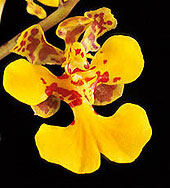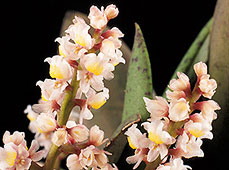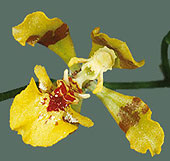|
Cultivation
There is no standard
way to cultivating Oncidium. It depends on the origin of the species.
Light
Some
of them like strong light but never direct sun. Sometimes, it occurs in
the nature however, in this case, there are some elements that counterbalance
this condition.
Some species like average light or can bloom in lower light or higher light
such as O. pumilum (nowadays Lophiaris pumila), O. jonesianum,
O. sarcodes, O. flexuosum, O. lanceanum (nowadays Lophiaris
lanceana). Some species like more luminosity during the winter and more
protection during the summer such as O. phymatochilum. Some times,
putting the plant just a few centimeters away, is enough to change the way
of flowering.
|
|
Humidity & watering
In
general, they love an alternation of wet and dry conditions.
The watering should be intense during the grow period since the news shoots
until the maturation of the pseudobulbs. Keep the substrate moist but not
soaked however for the so-called equitants (nowadays Tolumnia), the
compost should not be allowed to dry out completely.
Some need a rest period which can be severe, some do not. However the reduction
should not provoke a wrinkle in pseudobulbs and leaves.
In general, in south and southeast of Brazil, where the most part come,
the winter is dry so during this period, in the nature, they do not receive
much water only the mist of the night.
The cerrado (woodland savanah) and tablelands (chapadas and campos de altitude)
are also very dry during this season. The species which come from Atlantic
Forrest need more humidity than those which come dry region.
Reduce water when blooming.
|
Feed
In
hotter regions, we can apply fertilizer all year round, but in cooler climate
it seems not to be desirable. In this case, in my opinion, we should not
fertilize during the second part of the autumn and during the winter. I
live in Brazil, in Rio de Janeiro, so the climate of my region is hot and
during the winter the temperature is just more agreeable and, in general,
I apply weekly a foliar balanced fertilizer (10-10-10, 7-7-7) for three
times. The fourth, I apply a phosphate fertilizer to induce flower. Three
months before the blooming season, I invert this application and use for
three times the phosphate fertilizer and the fourth I apply a balanced one.
|
Temperature
Some
species can be cultivated under every condition such as |
but,
in general, the species are not very tolerate to a inadequate conditions
of temperature indicated to its cultivation.
A plant which comes from a cool temperature, such as Oncidium crispum
or O. concolor, cultivated in warmer conditions, will bloom and perhaps
grow in a reasonable way for 2 or 3 years. Then, suddenly, it will become
weak and die with no apparently reason except for being cultivated under
inadequate temperature. So, choose species or hybrids according to the temperature
you have: |
|
O. baueri, |
 O. cebolleta,
O. cebolleta,
|
|
O. ciliatum, O.
flexuosum, O. fimbriatum |
 O. lanceanum(nowadays
Lophiaris lanceana),
O. lanceanum(nowadays
Lophiaris lanceana), |
|
O. macropetalum, O. micropogon, |
 O. morenoi
(nowadays Lophiaris morenoi),
O. morenoi
(nowadays Lophiaris morenoi), |
O.
nanum (nowadays Lophiaris nana), O. sarcodes, between
others, can be cultivated under warmer temperatures, without problems. |
| Under
intermediate to cool conditions, choose: |
|
O. cheirophorum, |
 O. cornigerum,
O. cornigerum, |
 O. crispum,
O. crispum, |
 O. cruciatum,
O. cruciatum, |
| O.
curtum, O. divaricatum, |
 O. forbesii,
O. forbesii, |
O. gardneri, O. hastilabium, O. lietzei, O. pubes, O. ornithorhynchum, O.
pulvinatum, , O. robustissimum, O. sarcodes, O. sphegiferum, O. varicosum,
among others. The species of the Cyrtochila section (nowadays, considered
as a independent genus, Cyrtochilum) and of the Cucullata
section (High altitudes of the Andes) require very cool condition to be
cultivated and need less light than the other species. O. carderi, O.
falcipetalum, O. lamilligerum, O. macranthum, O. orgyale, O. serratum,
etc.. (nowadays Cyrtochilum carderi, C. falcipetalum, C. lamilligerum,
C. macranthum, C. orgyale, C. serratum) e O. cucullatum, O. dayanum, O.
olivaceum, O. phalaenopsis, O. rhodostictum, etc.
Ventilation
As many other
genera, Oncidium loves a light breeze in order to ventilate its roots
but it does not like strong wind which can dry out completely its roots
and makes them shrivel.
See Data Center where you will
find some species and hybrids with indication of the way to cultivating
them.
Repotting, composts, supports & containers
Oncidium
can be cultivated in many containers, tree fern slabs, cork bark, logs,
alive trees, plastic and earthenware pots with tree fern fiber, coxim or
conifer bark. |
| The
species with creeping rhizome such as |

 O. cebolleta,
O. cebolleta,
 O. lanceanum(nowadays
Lophiaris lanceana),
O. lanceanum(nowadays
Lophiaris lanceana), O. morenoi
(nowadays Lophiaris morenoi),
O. morenoi
(nowadays Lophiaris morenoi),  O. cornigerum,
O. cornigerum, O. crispum,
O. crispum, O. cruciatum,
O. cruciatum, O. forbesii,
O. forbesii,

